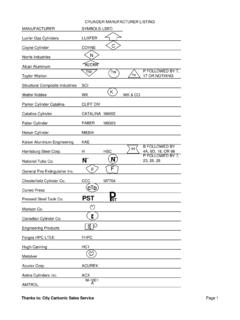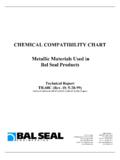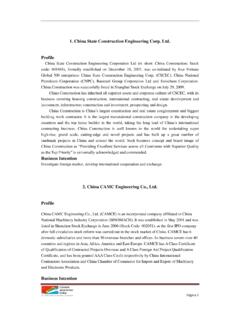Transcription of Scenic Harmony - damassets.autodesk.net
1 Featuring one of the most dramatic landscapes in the world, Guilin, China, is an increasingly popular tourist destination. People travel vast distances to see how the area s distinctive karst limestone hills and waterways combine to form unique vistas. Guilin is also home to a vibrant manufacturing sector, which attracts business travelers. Guilin s beauty has inspired countless photographers and artists. More recently, it inspired the architects at Beijing Institute of Architectural Design (BIAD) to design an airport expansion that resonates with the area s natural beauty. Each year, nearly 6 million people pass through the Guilin Liangjiang International Airport.
2 The airport s single terminal, a 1990s-era structure, serves more than 31 airlines. Recognizing that this volume of traffic was rapidly becoming unsustainable for the airport, Chinese authorities decided to add a second terminal. When it opens in 2018, Terminal 2 will span more than 100,000 square meters and add 24 gates to the airport s capacity. Qichen Jiang, director of the BIM center of the steel Structure engineering Company (SSEC), gives her perspective on the airport: The airport s roof features a double-arching design and peaked shapes that mimics Guilin s landscape. Beautiful limestone hills provide a backdrop to the new terminal and harmonize with the design.
3 The unusual shape presented many steel engineering , detailing, and construction challenges, but the project team overcame each one to deliver a terminal suited to the area. Scenic HarmonySmart steel detailing helps firm reduce labor by 20% to deliver a new airport terminal in China that embodies an area s distinctive landscapeThe Guilin Liangjiang International Airport Terminal 2 project will span more than 100,000 square meters and add 24 gates to the airport s capacity. Images courtesy of Beijing Institute of Architectural BIAD & SSECThe Beijing Institute of Architectural Design (BIAD) is a large-scale, state-owned architectural design and consulting institute established in 1949, the same year the PRC was Structure engineering Company (SSEC) is part of China Construction Eighth engineering Division (CCEED) of the state-owned China State Construction engineering Corporation.
4 A VISIONARY DESIGNThe SSEC is responsible for the steel detailing, fabrication, and construction of Terminal 2. SSEC is part of China Construction Eighth engineering Division (CCEED) of the state-owned China State Construction engineering Corporation. Given the complexity of the steel structure, SSEC plays a crucial role in realizing BIAD s U-shaped Terminal 2 includes four floors three above ground and one below. The curving steel roof is a large-span, double-curved-arch structure. Additional steel components include supports, boarding-gate structures, and connection bridges. In total, the SSEC will use more than 11,000 tons of steel to construct the terminal structure.
5 Fabricated off-site, each piece of steel must be placed and welded according to a precise plan. Any fabrication or construction error could delay the project or add unexpected costs. The team at SSEC realized that precision steel detailing would prove crucial to the success of the project. MODELS BRING INTELLIGENT DATATo address the project s challenges, the SSEC team relied on Building Information Modeling (BIM) tools for detailing. BIM is an intelligent process that uses 3D models to drive design, detailing, fabrication, and construction. In contrast, a traditional process is based on 2D drawings. A 2D process not only lacks the visualization advantages of 3D, but the underlying data lacks intelligence that can be applied to processes like sustainable design.
6 The SSEC team s legacy tools for steel detailing didn t enable smooth data flow from the engineering design which was in Autodesk Revit , and they couldn t handle the complexity of the structure s curves. We saw that we might need to change our detailing application to meet the challenge presented by the project, says Jiang. It was essential to choose a tool that could help us deliver the project. At the same time, we didn t want something that would take our team a long time to learn. In evaluating its options for model-based detailing, SSEC prioritized ease of use and the ability to handle curves. The team discovered that Autodesk Advance steel detailing software seemed to meet its criteria, but they wanted to be sure.
7 SSEC then launched a pilot to test Advance steel as compared to its prior BIM detailing software. Advance steel proved better able to handle curves, and SSEC was pleased to find that it stood out in other ways, too. Jiang explains, Advance steel could clearly help with the complex aspects of the project. It was also faster for many more traditional detailing tasks. We liked the fact that its interface is based on AutoCAD software, which is familiar in the industry. This helped our team learn to use it much more quickly than is typical with unfamiliar software. Images courtesy of Beijing Institute of Architectural steel could clearly help with the complex aspects of the project.
8 It was also faster for many more traditional detailing tasks. We liked the fact that its interface is based on AutoCAD software, which is familiar in the industry. QICHEN JIANG, Director of the BIM Center of the steel Structure engineering Company (SSEC)INTEROPERABILITY FUELS COLLABORATIONA dvance steel software also supported the degree of interoperability that the team sought. SSEC could bring models created in Autodesk Revit building design software which was used for the structural engineering design into Advance steel without the loss of data. Should the need arise, SSEC could also establish a bidirectional link between Advance steel and Revit, making it easier to incorporate late design changes into their process.
9 Just as importantly, Advance steel offers support for Industry Foundation Class (IFC) standards, and the project team planned to follow IFC standards to exchange data on the project. We were pleased with the interoperability of Advance steel , says Jiang. It was easy to bring the structural models created in Revit into Advance steel . We did not have to redraw elements, which was common with our prior software. With the decision to use Advance steel , the SSEC team began detailing the structural steel model. MASTERING CURVESIt was then time to confront their next major challenge: detailing the complicated double-curving arch quickly and efficiently.
10 They needed to determine the optimal way to section the arch for fabrication. Working with the structural engineer, they turned to Dynamo software for computational lets designers create visual logic to design workflows that drive the geometry of design models. Using Dynamo, the team computed how to divide the arch into 250 parts. They then synchronized with the design model in Revit, and exported the model into Advance steel . Once in Advance steel , the detailers were able to detail the arches, readying them for fabrication. Dynamo helped us find efficient ways to section the arches, says Jiang. Such calculations would ve taken much longer without BIM-based computational design.


















